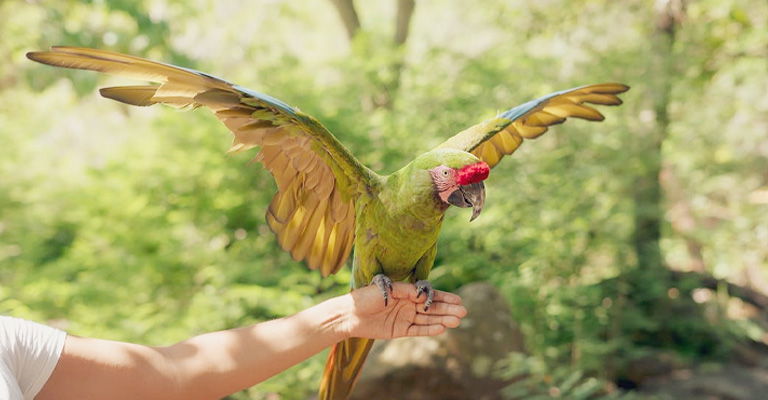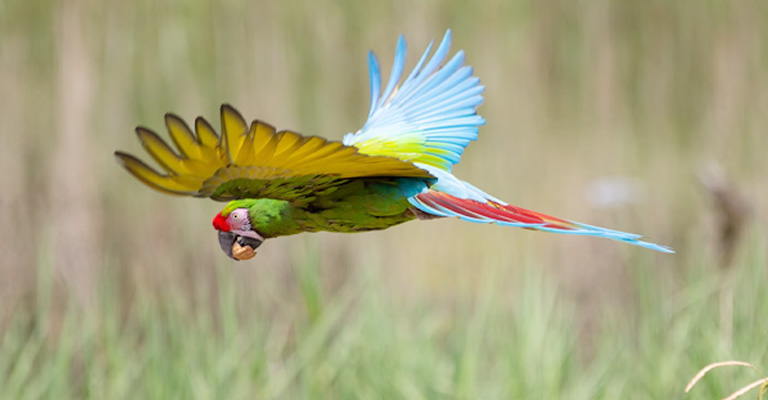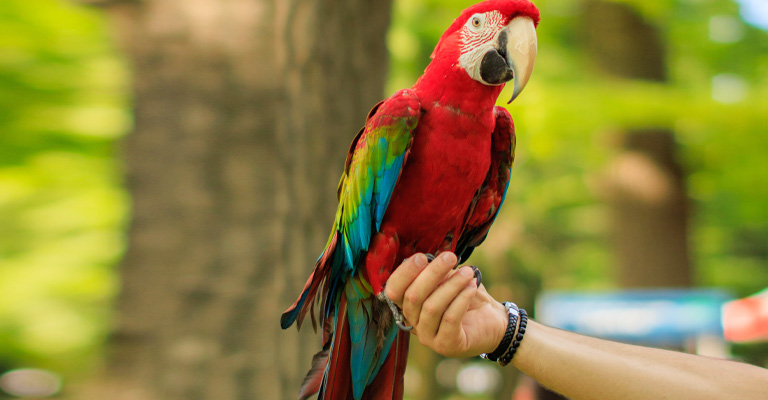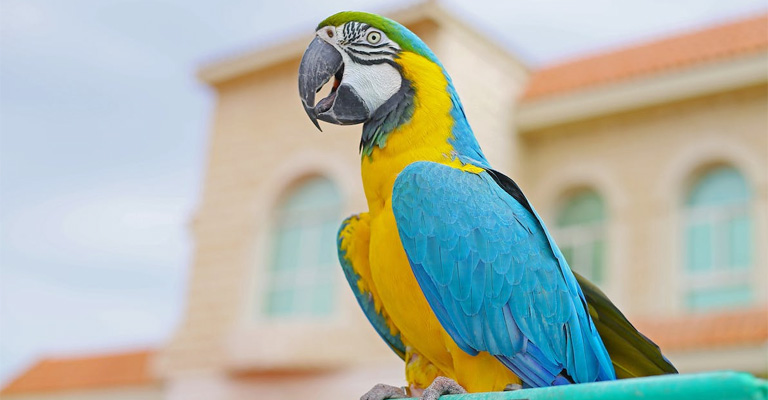Training a Macaw can be a rewarding and enriching experience for both you and your feathered companion. These vibrant and intelligent birds, known for their striking plumage and charismatic personalities, thrive when provided with mental stimulation and social interaction.
Whether you’re starting with a young Macaw or embarking on training with an older bird, this guide will provide you with essential tips and techniques to foster a strong bond and teach them crucial commands.
From basic training commands like “Step Up” and “Quiet” to more advanced tricks and socialization skills, you’ll discover the keys to a successful training journey.
With patience, consistency, and positive reinforcement, you can unlock your Macaw’s full potential and build a harmonious relationship based on trust and mutual understanding.

Is It Difficult to Train a Macaw?
Training a Macaw can be challenging due to their intelligence, independence, and strong personalities. Macaws are highly social birds that require a lot of time, patience, and consistency in their training.
They can learn various tricks and commands, but it takes dedication and a deep understanding of their behavior.
One of the difficulties in training Macaws is their natural instinct to vocalize loudly, which can be hard to control. Additionally, they have a beak that can cause injury if not handled properly.
Positive reinforcement techniques, such as rewarding good behavior with treats or praise, are essential for successful training.
Training a Macaw is not impossible, but it demands commitment and knowledge of their specific needs and behaviors. Enlisting the help of a professional avian trainer may be beneficial for those new to Macaw ownership or facing challenges in their training efforts.
Getting to Know Your Macaw
Getting to know your Macaw is essential for building a strong and healthy bond with this intelligent and social bird. Here are some tips to help you understand and connect with your Macaw:
Observe Behavior
Spend time observing your Macaw’s behavior to understand its likes, dislikes, and moods. Notice how it reacts to different situations, toys, and people.
Social Interaction
Macaws are highly social birds. Spend quality time with your Macaw, talking to it, playing games, and providing companionship. They thrive on attention and can become lonely if left alone for extended periods.
Body Language
Learn to interpret your Macaw’s body language. Understand signs of contentment, discomfort, and stress. This knowledge will help you respond appropriately to its needs.
Positive Reinforcement
Use positive reinforcement techniques like treats, praise, and toys to reward good behavior. This encourages your Macaw to repeat desired actions and builds trust.
Training
Invest time in training your Macaw. Start with basic commands and gradually introduce more advanced tricks. Be patient, and consistent, and use gentle methods.
Diet and Nutrition
Provide a balanced diet to ensure your Macaw’s health. Consult with an avian veterinarian to determine the best diet for your specific Macaw species.
Exercise and Enrichment
Macaws are active birds. Provide ample opportunities for physical exercise and mental stimulation through toys, puzzles, and playtime.
Respect Space
Respect your Macaw’s need for personal space. Don’t force interactions, and allow it to come to you when it’s comfortable.
Healthcare
Schedule regular check-ups with an avian vet to monitor your Macaw’s health. Early detection of health issues is crucial.
Patience and Love
Building a strong bond with your Macaw takes time. Be patient, gentle, and loving in your interactions. A trusting relationship is the foundation of a happy Macaw-human partnership.
Remember that every Macaw is unique, so adapt your approach to suit your bird’s individual personality and needs. Over time, you’ll develop a deeper connection and understanding of your Macaw, creating a fulfilling companionship for both of you.
Setting Up the Right Environment

Creating the right environment for your Macaw is crucial to its well-being and happiness. Here are key considerations when setting up the ideal living space for your feathered friend:
- Cage Size: Invest in a spacious, well-constructed cage. Macaws need ample room to move, stretch their wings, and exercise. The cage should allow them to fully extend their wings without touching the sides.
- Location: Place the cage in a central area of your home where your Macaw can feel part of the family. Avoid drafts, direct sunlight, and extreme temperature fluctuations.
- Perches: Provide sturdy, varied perches of different sizes and materials to promote foot health. Natural branches are excellent choices, as they offer both exercise and comfort.
- Toys and Enrichment: Macaws are intelligent and require mental stimulation. Offer a variety of toys, puzzles, and foraging opportunities to keep them engaged and prevent boredom.
- Nutrition: Set up a designated feeding area within the cage. Provide fresh water, a balanced diet of pellets, fresh fruits, vegetables, and occasional nuts. Avoid toxic foods, like avocado and chocolate.
- Cleanliness: Regularly clean the cage, removing uneaten food, droppings, and soiled bedding. This helps maintain a hygienic environment and prevents health issues.
- Privacy: Macaws sometimes need their own space. Provide a sheltered corner or a small, enclosed area within the cage where they can retreat when they want privacy.
- Cage Accessories: Include dishes for food and water, as well as a designated area for bathing. Macaws enjoy bathing, and it helps maintain feather health.
- Social Interaction: Macaws are social birds, so place the cage where they can interact with family members and observe household activities. They thrive on attention and conversation.
- Safety: Ensure the cage is escape-proof and free from hazards like toxic plants, chemicals, or small objects that your Macaw could ingest.
- Training Area: Dedicate a separate space outside the cage for training sessions and playtime. This area should be free from distractions and potential dangers.
- Natural Light: Whenever possible, provide access to natural sunlight or full-spectrum UV lighting, as it’s beneficial for your Macaw’s overall health.
- Temperature Control: Maintain a comfortable temperature for your Macaw. They are sensitive to extreme heat and cold, so use heating or cooling as needed.
Macaws are social birds that require daily interaction, mental stimulation, and physical activity outside of their cages. Create a routine that includes playtime and socialization to keep them happy and well-adjusted. Providing the right environment is essential for their physical and emotional well-being.
Basic Training Commands for Macaw

Training your Macaw with basic commands is essential for their safety and your relationship. Here are seven fundamental commands to teach your Macaw:
Step Up
Teach your Macaw to step onto your hand or a perch when you say “Step Up.” Start by offering a treat or using a favorite toy to lure them onto your hand or perch. Use the command consistently and reward them when they comply. This command helps with handling and allows you to move your Macaw safely.
Step Down
Complementing “Step Up” is “Step Down.” This command encourages your Macaw to move from your hand or perch to another location. Use it when you want them to exit your hand or perch onto a designated spot, such as a play stand or cage.
No
“No” is a crucial command for discouraging unwanted behavior. When your Macaw engages in undesirable actions like biting or chewing on inappropriate objects, firmly say “No.” Be consistent and follow it with redirection to a suitable toy or activity. Avoid shouting or scaring your bird.
Stay
Teaching your Macaw to stay in one place is essential for safety. Start with short durations and gradually increase the time. Use the command “Stay” and reward them for remaining still. This is particularly useful when you need them to stay in one place, such as during cage cleaning.
Come
Encourage your Macaw to come to you when called by using the “Come” command. Begin in a controlled environment, and as they become comfortable, practice in different areas of your home. Offer treats and praise when they respond correctly.
Quiet
Macaws are known for their loud vocalizations. To manage their noise level, introduce the “Quiet” command. Gently say “Quiet” when they are making noise and reward them when they stop vocalizing. Consistency is key in teaching this command.
Target Training
Target training involves teaching your Macaw to touch a specific object (usually a stick or target) with their beak. This command is not only fun but also serves as the foundation for teaching more advanced tricks. Use the “Target” command and reward them when they touch the target.
Patience, consistency, and positive reinforcement are essential when training your Macaw. Keep training sessions short and enjoyable, and always end on a positive note. Building a strong bond with your Macaw through training will enhance their well-being and the quality of your relationship.
Tips for Macaw Socialization and Interaction

Socialization and interaction are crucial for the well-being of Macaws, highly intelligent and social birds. Here are seven tips to help you foster positive socialization and interaction with your Macaw:
Consistent Quality Time
Dedicate daily, consistent quality time with your Macaw. Macaws thrive on companionship and attention. Spend time talking to, playing with, and interacting with your bird. A lack of socialization can lead to behavioral issues and loneliness.
Positive Reinforcement
Use positive reinforcement techniques to reward desired behaviors. Offer treats, praise, or toys when your Macaw behaves well or follows commands. This encourages them to repeat those behaviors and builds trust.
Teaching New Tricks
Macaws are intelligent and enjoy learning new tricks and commands. Engage in regular training sessions to mentally stimulate your bird. Start with basic commands and gradually progress to more advanced ones. Be patient and use gentle, reward-based training methods.
Handling and Touch
Gradually get your Macaw comfortable with being handled. Begin with short sessions of gentle petting and gradually progress to picking them up. Always approach calmly and allow them to come to you when they’re ready.
Social Exposure
Introduce your Macaw to different people, including family members and trusted friends. Macaws can be wary of strangers, so early and positive social exposure can help them become more comfortable with new faces.
Safe Playtime
Provide supervised out-of-cage playtime in a secure and bird-proofed area of your home. Ensure there are no hazards like toxic plants, electrical cords, or other pets that could harm your Macaw.
Interactive playtime helps them burn energy and strengthens their bond with you.
Verbal Interaction
Macaws are excellent mimickers and can learn a wide vocabulary. Talk to your Macaw regularly, using a gentle and encouraging tone. Engage in conversations with them, and they may pick up words and phrases over time.
Be cautious with your language, as they can learn both positive and negative words.
Each Macaw has its unique personality and comfort levels, so adjust your interactions accordingly. Respect their boundaries, and if they show signs of stress or discomfort, give them space and time to calm down.
Always prioritize their well-being and happiness in your socialization efforts, and your Macaw will thrive as a beloved member of your household.
Advanced Training Techniques for Macaw
Advanced training techniques can help stimulate your Macaw’s mental abilities and strengthen the bond between you. Here are seven advanced training techniques with explanations:
Flight Recall
This advanced technique involves teaching your Macaw to return to you on command after flying. Start in a controlled, enclosed environment, and use the “Come” command while they are in flight.
Gradually increase the distance and complexity of the recalls. This exercise enhances their recall skills and provides exercise.
Talking and Mimicking
Macaws are known for their talking abilities. Encourage speech by consistently using words or phrases you want them to learn.
Repeat the words in a clear and enthusiastic manner. Reward them with praise and treats when they mimic your speech.
Trick Training
Go beyond basic commands and teach your Macaw fun tricks like spinning in a circle, waving, or playing dead.
Use positive reinforcement and break down the trick into small, manageable steps. Patience and consistency are key to success.
Target Stick Agility
Advance target training by creating an agility course with multiple target sticks at different heights and angles.
Guide your Macaw through the course using the target stick, rewarding them for successfully completing each section. This enhances their coordination and mental agility.
Puzzle Toys
Introduce complex puzzle toys that require problem-solving skills. These toys challenge your Macaw’s intelligence and keep them engaged for extended periods. Hide treats inside the puzzles to reward their efforts.
Retrieve Objects
Train your Macaw to retrieve objects for you. Start with simple items and gradually progress to more complex ones. Use the “Retrieve” command and reward them when they bring the item back to you. This exercise taps into their natural curiosity and problem-solving abilities.
Harness Training
If you want to take your Macaw outdoors safely, harness training is essential. Start by allowing your Macaw to get used to wearing the harness indoors.
Gradually introduce the outdoors in a safe and controlled manner. Ensure they are comfortable with the harness before venturing outside.
Always prioritize positive reinforcement, patience, and safety in advanced training techniques. Keep training sessions short and enjoyable, and be mindful of your Macaw’s comfort and limitations.
Advanced training not only provides mental stimulation but also deepens the bond between you and your feathered companion.
FAQs
Training times vary, but basic commands can take a few weeks to several months. Advanced training and tricks require more time and patience, often extending beyond a year.
Consistency, positive reinforcement, and the individual bird’s personality play significant roles in training duration.
Healthy options like unsalted nuts, seeds, and fresh fruits work well. Macaws love almonds, walnuts, and slices of apple or banana. Ensure treats are small, bite-sized, and offered in moderation to prevent overindulgence.
Yes, it’s possible to train older Macaws, but it may require more time and patience compared to training younger birds.
Older Macaws might have established habits, so consistency and positive reinforcement are crucial for success.
Biting is common during training. When your Macaw bites, avoid reacting negatively or pulling away abruptly, as it can reinforce the behavior.
Instead, calmly withdraw and resume training later. Focus on building trust and addressing the underlying cause of the biting.
While you can train a Macaw on your own with patience and dedication, consulting a professional avian trainer can be valuable, especially for challenging behavior issues or advanced training.
They can provide guidance, techniques, and personalized advice to ensure successful training outcomes.
Wrapping Up
Training your Macaw is not just about teaching commands; it’s about building a lifelong connection filled with communication, love, and companionship. As you embark on this training journey, remember that each Macaw is unique, so adapt your approach to their individual needs and preferences.
Through the training process, you’ll witness the remarkable intelligence and adaptability of these magnificent birds, creating a bond that will enrich your lives for years to come.
So, embrace the adventure of Macaw training, and enjoy the journey of discovery with your feathered friend. If you have any issues understanding the problem, please let us know. Thank you for your time.